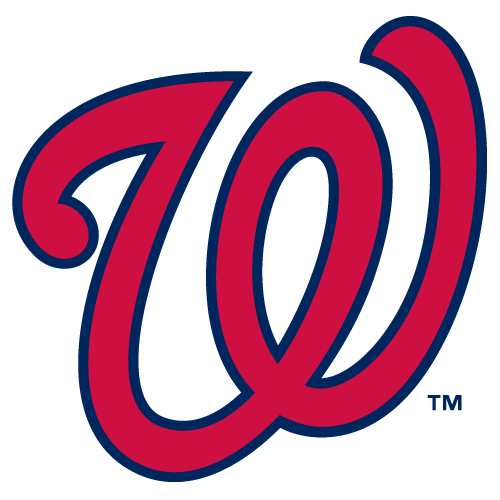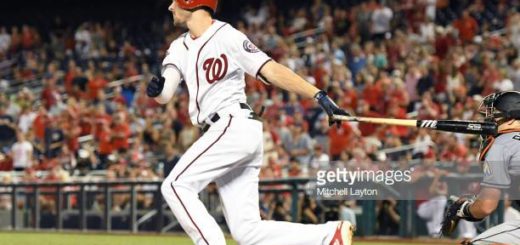Nationals Top Prospects Report
Well, the Nationals have a lot of top prospects in their system. Some proof of this from last year is Juan Soto, who deserved to be NL Rookie of the Year, but he unfortunately lost to Ronald Acuna.
Here’s a look at this year’s top 30 Nationals prospects. We are also going to name the year you should expect him to start in the big leagues, which will be in parentheses.
VICTOR ROBLES – OF (has played in MLB): Robles has already played in the bigs so far, but he’s the number one prospect for the Nats. Expect him to start in centerfield next season, as he is a really strong fielder with an exceptional arm. The 21-year old is a contact hitter, but don’t expect a lot of power to come from him, as he is not a home run hitter, even though he hit his first home run against the Marlins this past September. He also has exceptional speed, so expect him to run a lot.
CARTER KIEBOOM – SS (2019): His older brother, Spencer, is already a catcher for the Nats. Carter is not much of a hitter, but he can hit home runs, as he hit a total of sixteen home runs (eleven in A+, five in AA). He’s got good hand-eye coordination, but he doesn’t have speed. Don’t expect him to play shortstop, but expect him to play second base instead. Kieboom is a guy Nats fans should be excited about seeing in the big leagues.
LUIS GARCIA – SS (2021): Fully known as Luis Victoriano Garcia, this 18-year old was one of two Nats prospects to play at the Futures Game last season (the other being Kieboom). As I said, Garcia is only 18 years old, and he has already played as high as A+ for the Potomac Nationals. The Nationals are expecting a lot from this kid, and some are saying that he could be brought up as soon as THIS SEASON. Don’t expect it though, as he still needs some time to develop.
MASON DENABURG – RHP (2022): Denaburg was the Nationals’ first-round draft pick this past season. Denaburg is a starting pitcher out of Florida, but has also played catcher and outfield. Denaburg throws and bats right handed. His caliber consists of a fastball, changeup, and curveball. His fastball is considered his best pitch, with a scouting grade of 60 out of 80. However, Denaburg does have some issues in the past with his biceps, as they have gotten injured.
WIL CROWE – RHP (2020): Wil Crowe is was the Nats’ 2017 second-round pick. He can throw a fastball, curveball, slider, and changeup. Like Denaburg, the best pitch for Crowe is his fastball, with a scouting grade of 60. He does have control issues, and has had Tommy John surgery in the past, and that could be some problems in the future for the Nationals and Wil Crowe. The Tommy John surgery, however, had no effect on his velocity.
SETH ROMERO – LHP (2019): Seth Romero is a character, to say nicely. He was the Nationals’ first-round pick in 2017. Romero throws a fastball, slider, and changeup. His slider is considered the best pitch for him. During college, he was a closer, but the Nats expect him to pitch as a starter. Remember how I said character? I say that because he has had some off-field issues, that resulted in him getting kicked off the University of Houston baseball team for violating athletic department policy, and this past spring training, where he was sent home early for violating a Nationals team policy.
YASEL ANTUNA – SS/3B (2021): Yasel Antuna is a kid that, like Juan Soto, Robles, and Garcia, was brought up in the system as an International Amateur. Antuna is a switch-hitter, something the Nationals need more of, and he is more effective batting on the left side, another thing the Nationals could use more of. He has a very strong arm, and could be a starter eventually in the infield, as he can also play most of the infield.
TIM CATE – LHP (2021): The Nationals drafted Tim Cate in the second round last season. His caliber consists of a fastball, curveball, and changeup, with his curveball being his best pitch. This was graded 65 out of 80 by scouts. Cate, a pitcher drafted out of UConn, has been a starter all of college, and the Nats can hope to get good things from him. Scouts have considered his curveball the best in last season’s draft class, and he uses it a lot. He can command the strike zone, no matter the count.
RAUDY READ – C (2019): Raudy Read was supposed to start playing this year, but the Nationals were concerned after he was suspended for violating MLB’s drug policy this March. Read is a power hitter, and has “natural hitting ability”. Even as he was limited in 2018, expect him to be called up in 2019, but not to play much as the Nats did make upgrades at catcher in Yan Gomes and Kurt Suzuki.
GAGE CANNING – OF (2021): Gage Canning was drafted last season in the fifth round by the Nationals. Canning is a consistent contact hitter, and he showed it throughout his entire playing time as an ASU Sun Devil. This past college baseball season, Canning had a .369 batting average. Yeah, you read that right. .369 BATTING AVERAGE. Scouts have said he can do the any little thing that helps, and he’s also got speed. He could be a solid fourth outfielder, and the main one on the bench. He just needs to improve on power, and then he could possibly be a starter for the Nats.
STERLING SHARP – RHP (2019): First off, let me just admit I hadn’t even heard of this kid. Shepard was drafted by the Nats in the TWENTY-SECOND ROUND in 2016. He was drafted very late, yet he is the Nats’ NUMBER 11 PROSPECT. What a term events for a kid who can throw fastball, slider, and changeup. Sharp also came out of Division II’s Drury University in Springfield, Missouri. Sharp has a low-90s fastball that could lead to weak ground outs a plenty. He also has a very impressive slider that the organization has taken into account.
TELMITO AGUSTIN – OF (2019): If the Nats lose Bryce Harper, you should consider calling up this twenty two year old from the Virgin Islands. He is a left-handed hitter who hits a lot of balls on the ground, but can also expand the gap. He can also bunt well, as his speed is above-average, which could lead to a lot of infield base hits. When the Nats first signed him as an international amateur, he was not a good fielder, but he has progressed much more over the years into an average fielder. Don’t be looking for him to be a home run hitter, as he doesn’t have much power.
JOSE SANCHEZ – SS/2B/3B (2021): Jose Daniel Sanchez, AKA Jose Sanchez, is an all-around infielder than seems to be able to play any position in the infield except for first base. He was part of the signings that were up-the-middle improvements for the future, which included prospects like Garcia and Antuna, back in 2016. Sanchez is not a hitter, but he is an exceptional fielder, with both his fielding and arm graded by scouts as 60 out of 80. He also knows how to run the bases, but he doesn’t have good speed.
TRES BARRERA – C (2019): Another catcher the Nats have in their system, Barrera is a hard-hitting right handed batter, who gets power from his combination of bat speed and strength. Drafted by the Nats in the sixth round of 2016, Barrera has an above-average arm that should be able to throw out runners pretty easily, as the Nationals were not good in that category last season. Barrera might have some trouble, however, getting playing time if he is getting called up, as he has to deal with Yan Gomes and Kurt Suzuki, as well as the possibility of the Nats calling up Read.
NICK RAQUET – LHP (2020): A left-handed starting pitcher, Raquet was drafted in the third round of 2017. A good fastball, an above average changeup, as well as a curveball and slider make up this twenty year-old’s pitching caliber. He has good velocity, but some accuracy problems, which can hopefully be worked on during his time in the minors.
JAMES BOURQUE – RHP (2019): James Bourque was a name that has been on the news lately, as he was the only pitcher the Nats blocked from being taken in the Rule 5 draft. Bourque was drafted by Washington in the fourteenth round in 2014. The only two problems with him are that he can only throw two pitches, a fastball and curveball, which have both been graded by scouts as 60 out of 80. Bourque is probably going to be a reliever for the Nats when called up, as he is iffy when starting.
JAKE IRVIN – RHP (2019): Drafted in the fourth round this past year, Irvin is a starting pitcher with a fastball, slider, and changeup up his sleeve. He needs to work on the changeup, as that is only graded as 45 out of 80 by scouts. He has improved a lot in terms of control and command over the years. He repeats his delivery well, and that could really help him in his career.
REID SCHALLER – RHP (2021): Schaller was also drafted this past season, but in the third round. He has a phenominal fastball that was graded 70 out of 80, but he (like Irvin) needs to work on his changeup. Schaller has had balls go between 95-98 MPH sometimes, and he shows little effort when he throws. He was originally able to be drafted in 2016, but he was prevented by having Tommy John surgery. The Nationals got interested in him because of the low mileage he has to present.
KYLE JOHNSTON – RHP (2020): Johnston was the Nationals’ sixth round draft pick in 2017, and has an above-average fastball and cutter, but the changeup needs to improve. He is expected to be in the bullpen, as he shined in the California Summer Collegiate League in 2016, and he is going to be a closer in the minors, and could lead to be a closer for the Nationals, which would improve for the Nats as he is young.
ISRAEL PINEDA – C (2022): One of only four players that I hadn’t heard of before, Pineda seems to be a young catcher with a good arm that is sure to improve. He is a contact hitter, who hit .273 in Short-season Auburn last year. Pineda is going to be a contact hitter, and that Nationals knew that when they sought him as an international amateur in July 2016. Take into account however that he did have season-ending surgery on his hand last year.
KYLE McGOWIN – RHP (has played in MLB): The other pitcher in the 2017 Danny Espinosa trade to the Angels, he and Trevor Gott are expected to make some big impact for the Nationals. Drafted in the fifth round of 2013 by the Angels, McGowin is a pitcher with a fastball, slider, and changeup, with the slider being his best pitch. He is injury-prone and this could effect his status of being able to play in MLB for the Nats. Expect him to come out of the bullpen mostly. Last season, in the time he played with the Nationals, he had a 5.87 ERA, a 0-0 record, and eight strikeouts in a total of five games.
TANNER RAINEY – RHP (has played in MLB): The Nationals got him this December for Tanner Roark from the Reds. Rainey is a right-handed pitcher who the Nationals expect mostly to come out of the bullpen. He played eight games last summer with the Reds, but struggled mightily, with a 24.43 ERA, 0-0 record, and seven strikeouts, while he also gave up twelve hits. He has command issues that need to be fixed before he can be in the Majors full-time.
GABE KLOBOSITS – RHP (2020): The third of these guys I hadn’t heard of before, Klobosits is a pitcher with an above-average fastball, as well as a splitter and a changeup. Drafted in the 36TH ROUND (yeah, you heard me), by the Nats in 2017, Klobosits is expected to make the big leagues in 2020, and it seems as if the Nats drafted a player better than expected. Take note that he had to have Tommy John surgery this past May.
LUIS REYES – RHP (2020): The final of four I didn’t know about, Reyes signed with the Nats as an amateur back in 2012. Reyes has a decent fastball and changeup, but an above-average curveball. Reyes would be expected to be out of the bullpen for the Nats when he comes up to the big leagues. He has a sinking fastball that can cause whiffs and a ton of groundouts.
TOMAS ALASTRE – RHP (2021): Alastre signed as an amateur back in 2014, and he is a guy with pitches that need to be developed. Fastball and curveball are fine, but he needs to work on the changeup, which seems to be a pattern for the Nationals’ prospects. He also needs to add more velocity before the Nationals decide to bring him up.
JOSE MARMOLEJOS – 1B/OF (2019): Like Read, Marmolejos was expected to make the big leagues last year. Jose has had lots of injuries in the past, and it shows as he was supposed to be brought up earlier. However, he has the stat line that got him to be an Eastern League All-Star this summer representing the AA Harrisburg Senators. Marmolejos has good contact, but needs to work on power, a trait that most first basemen have.
JACKSON TETREAULT – RHP (2020): A member of the 2017 draft class, Tetreault was taken in the seventh round by the Nats. He has an above-average fastball, an average curveball, and a changeup that needs to be developed. Tetreault also needs to work on control, because that is graded by scouts as 40 out of 80. He needs to work on that, as his ERA has been very bad in the minors so far. Scouts are worried that he won’t be able to go deep, and that he won’t be able to keep velocity, so watch out for that.
AUSTIN VOTH – RHP (has played in MLB): Voth was drafted by the Nats in the fifth round of 2013, and made his MLB debut last summer. His velocity is low, but he can get his fastball up to 94 MPH. He can also throw a slider and changeup. He started two out of his four games he played as a National, and had a 6.97 ERA, a 1-1 record, and struck out 11. He needs to be able to keep his pitches in the strike zone, as that was a significant issue for him in the base on balls category.
BRIGHAM HILL – RHP (2020): Hill was drafted in 2017 by the Nationals in round five. Unlike most of the pitchers mentioned here, he has an above-average changeup, which is actually his best pitch. He also throws a fastball and curveball. He used to throw a slider, but the curveball seemed to be a better pitch for him. He has issues about being able to go long-term, as he had Tommy John surgery in high school.
DREW WARD – 3B/1B (2019): Ward is a power hitter, and expect him to hit home runs. Drafted by the Nats in the third round in 2013, he is expected to go full-season by the Nats organization every season. He did have some struggles in 2017, as he had a wrist injury that wasn’t operated on until the offseason. The Nats will have to be careful with playing him in the Majors.
Well, that’s it. Here’s a report of the top 30 prospects in the Nationals organiation.






